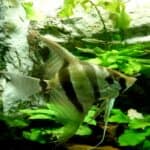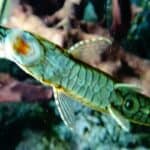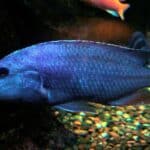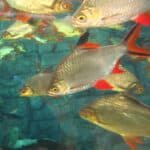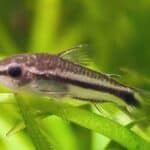How often should I feed my Sailfin Molly? What size tank should I get?
These questions probably crossed your mind if you’re planning to get a Sailfin Molly for your home aquarium. We understand it can be overwhelming when it’s your first time getting one of these beautiful fish. But don’t worry, Sailfins are common in community aquariums, and for a good reason- they are peaceful, easy-going, and undemanding.
This comprehensive guide discusses all issues involving this species and its maintenance in aquariums. By the end of this article, you’ll have a good understanding of what it takes to keep this fish happy and healthy.
So let’s get down to it!
Species Summary
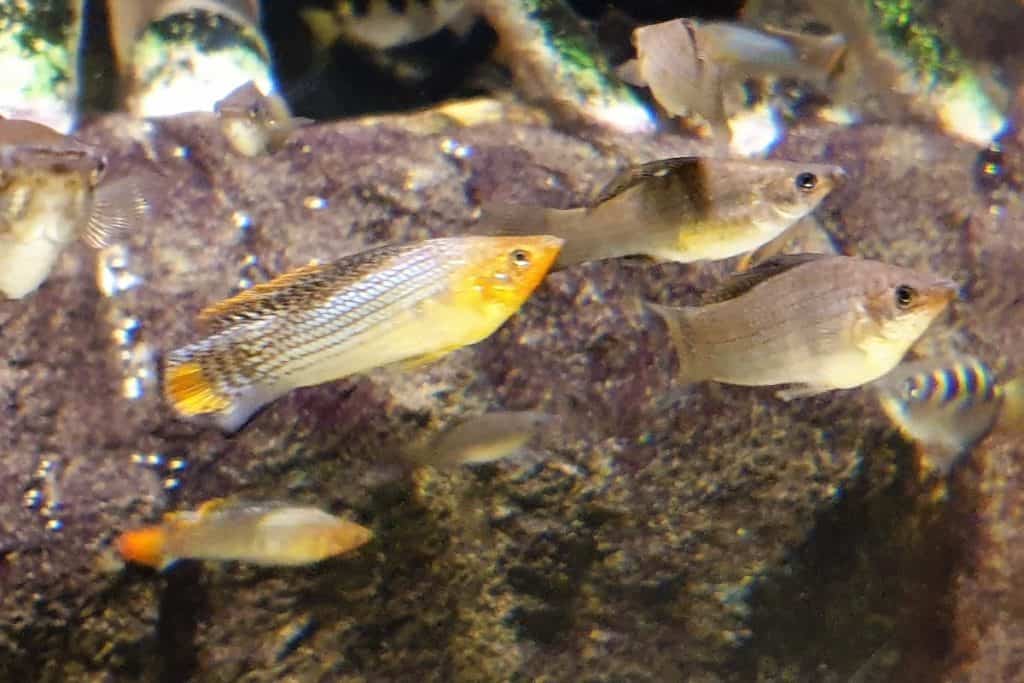
The Sailfin Molly is a tropical brackish-water fish belonging to the Poeciliidae family. It is widely distributed in North Carolina, the USA, Veracruz, Mexico, and several other countries. But here’s the interesting thing – these fish are highly resistant to salinity; that’s why they are often found in low-salt coastal areas, such as rivers, lakes, and estuaries
They also exist in different clear water streams, usually on algae-predominated shores. In environments with higher salinity, they appear together with the exacerbated presence of algae.
Moreover, the Sailfin Molly is a prevalent species in the fish-keeping community. They make excellent pets for beginners and collectors alike.
But despite being that popular, not many people know that in nature, Sailfin Molly inhabits brackish water very different from that typically kept in aquariums. The most common variety is the Black one, but several others can be found in stores; among them are the Black Lyra Tail, Balloon, Tiger, and Veil Dalmatian. The behavior and care for these varieties are practically the same.
Sailfins are suitable for a medium-sized to a large aquarium. They take on a unique pattern and coloration that’s quite appealing to viewers. So, if you’re looking for that extra push to get these fish finally, this is it! They are available in different color varieties, allowing you to build an eye-catching collection!
Sailfin Molly Care Guide
The Sailfin Molly is a peaceful fish that makes an excellent community fish. They can co-exist with other peaceful fish without any problems. But like other Mollies, they must be kept in groups with at least three individuals of the species.
Sailfins are doubtlessly some of the cutest fish out there, but they will show their best colors when well-taken care of. That said, you need to give them a balanced diet and house them in a proper aquarium to maintain their health and show off those colors!
Continue reading to learn more about how to care for this fish properly.
Tank Size
Sailfin Molly is an active fish and should be kept with ample clearance for swimming. A tank of at least 30″ x 15″ x 12″ or starting at 19 gallons is a good size to start with a trio. Like most fish, Sailfin’s overall health and well-being depend on how much space she has to swim around in. If you choose your tank wisely, provide lots of cover and hiding places, and keep the water clean and aerated, it should live a long and healthy life.
But space isn’t the only factor to consider when raising a Sailfin Molly. You also need to think about its tankmates and many other things.
Tank Mates
As mentioned, they are a very peaceful fish species. They get along well with other types of aquarium fish. As long as you avoid larger or aggressive species, your Sailfin Molly should do just fine.
These fish make great tankmates for the Sailfin Molly:
- Yoyo Loach
- Most Types Of Tetras
- Dwarf Gourami
- Harlequin Rasbora
- Cory Catfish
- Swordtail Fish
- Cherry Barb
- Celestial Pearl Danio
- Rosy Barb
- Platy
- Bristlenose Pleco
- Zebra Loach
Same Species Tanks
They are often used as a single species in assemblages of Biotope-type aquariums, where the original location of the species is imitated. They also thrive in specific assemblies that value the movement and color of the aquarium’s inhabitants.
If you plan to keep your Sailfin Molly along with your other fish collections, make sure to provide a large aquarium with open spaces for swimming, as this fish does not appreciate being overcrowded or cramped in small tanks.
Water Parameters
Sailfins are hardy fish that support a safe range of parameters, always leaning towards the alkaline side. But even the most durable Sailfin can get in trouble sometimes. When excess fish waste accumulates in the substrate, your fish might die from ammonia poisoning. Therefore, you should be mindful of eliminating anything that could degrade your tank’s water quality.
Keeping the pH level and hardness under control is just as important. The rule of thumb is to keep an ideal pH range of 7.0 to 8.5 and a hardness of 13 to 35 dH. Likewise, the perfect temperature for its maintenance is 70 to 79 F.
What to Put in Their Tank
Like any other aquatic animal, an aquarium heater and a filtering system are essential to keep the Sailfin Molly healthy.
Given the rusticity of the species, it can inhabit different aesthetic styles, from Amazonian themes to Asian and African ones. The aquarium’s decoration can be synonymous with success in breeding the species. As it is a very active species, you should leave an open space for swimming along with calmer areas.
Densely planted tanks help the population prosper, offering peaceful places to hide, breed, and feed. Not only that, these fish have a preference for well-lit aquariums.
Common Diseases
They are exceptionally disease-resistant fish with only a few parasites and diseases to worry about. But, for example, if you keep them in soft water or with an acidic pH, they will be susceptible to skin diseases and fin corrosion.
Food and Diet
This species, like other livebearers, is omnivorous with a strong tendency to be herbivory – feeding on algae, plant material, and small invertebrates.
In the wild, its primary diet is based mainly on plant-based foods. But this fish readily accepts all types of commercial feed without problems in aquariums.
Experienced fish keepers learn from firsthand experience that Sailfins are always hungry, so providing them with a varied and balanced diet is vital. The point? Providing a varied and balanced diet is key to demonstrating its full potential.
If you’re still reading this guide, we want to commend your commitment to learning everything about this fantastic fish. So bear with us a little more, and you will be on your way to putting everything you learned in this guide into action.
Lifespan
In an aquarium with all the correct parameters kept stable and with an ideal diet, this tetra can live for up to 5 years, the most common being around 3 years.
Contrarily, these animals are prone to live less in nature, as they are predisposed to diseases, environmental causes, and animal attacks.
Appearance
These small, oblong fish are generally gray with rows of stripe-like spots. Yet, some Sailfin populations have different colors, patterns, and body structures. Males have a large, showy dorsal fin; with other small fins, including a truncated tail fin.
What’s more, its exuberant back gave rise to its popular name, as when erect, the Sailfin Molly gives the appearance of a sail on a boat.
Overall, this fish, in its many striking features and color varieties, is of significant value to many fish keepers.
Size
The Sailfin Molly fish is the largest species of molly fish, quickly reaching 9 inches in length when well cared for and fed, but the everyday sight is around 6 inches.
Behavior and Temperament
While this tropical fish can thrive in a community aquarium, you should still keep it with other livebearers of similar size. We recommend maintaining a sex ratio of one male for every two females. This is because adult Sailfin can attack smaller ones, and adult male Sailfins can fight each other during mating.
We mentioned a few times in this guide that these fish are not aggressive, but this doesn’t guarantee that they won’t nibble on slow-moving or long-finned fish. You may have to deal with situations like this when the Sailfin is under stress due to limited space, lack of water changes, poor tank maintenance, etc.
Breeding
Captive breeding is extremely simple and is carried out commercially and in domestic aquariums worldwide. Breeding aquariums are usually used, with something at the bottom preventing the parents from eating the eggs until they are removed to another location.
And being ovoviviparous species, the male must internally fertilize the female. The eggs develop inside the mother until they hatch, and the fully developed offspring are born, dispensing with laying eggs somewhere.
Females can store sperm from the males to fertilize later and produce fingerlings quickly. After the gestation period, which can vary between three and four weeks, females give birth to fully formed offspring (about 10 to 100).
And here’s a fascinating truth: Sailfins exhibit no parental care. They are incredibly prolific and reproduce easily.
Gender Differences: Male vs Female
There is apparent sexual dimorphism in adult animals. The male has the most developed dorsal fin and gonopodium. Gonopodium refers to the anal fin adapted for reproduction that resembles the shape of a stick.
Females are larger, more robust, and do not have a gonopodium. They have typical anal fins instead.
Sailfin Molly Fun facts
● An ideal fish for any newbie to aquarium hobbyist and found in virtually any retail store around the planet.
● Many molly fish varieties are used in aquarium fish as ornamental, with many color variations.
● This species is prevalent in the aquarium hobby and commercially reproduced in several countries, including its different strains.
● Its larger dorsal fins and small dark rectangular spots set it apart from Poecilia velifera. It also has different types of colored patterns, even in its wild form.
In conclusion, caring for a Sailfin Molly is really not that difficult. Just follow a few guidelines, and you’ll end up with a healthy fish that is happy and needs nothing more than occasional maintenance.
References.
Baensch, H.A. and R. Riehl, 1985. Aquarien Atlas. Band 2. Mergus, Verlag für Natur-und Heimtierkunde GmbH, Melle, Germany. 1216 p.
Hugg, D.O., 1996. MAPFISH georeferenced mapping database. Freshwater and estuarine fishes of North America. Life Science Software. Dennis O. and Steven Hugg, 1278 Turkey Point Road, Edgewater, Maryland, USA.
Page, L.M. and B.M. Burr, 1991. A field guide to freshwater fishes of North America north of Mexico. Houghton Mifflin Company, Boston. 432 p.
Robins, C.R., R.M. Bailey, C.E. Bond, J.R. Brooker, E.A. Lachner, R.N. Lea and W.B. Scott, 1980. A list of common and scientific names of fishes from the United States and Canada. Am. Fish. Soc. Spec. Publ. (12)1-174.



